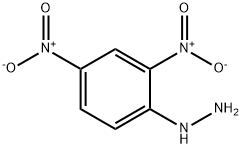
2,4-динитрофенилгидразин
- английское имя2,4-Dinitrophenylhydrazine
- CAS №119-26-6
- CBNumberCB4852908
- ФормулаC6H6N4O4
- мольный вес198.14
- EINECS204-309-3
- номер MDLMFCD00007578
- файл Mol119-26-6.mol
| Температура плавления | 197-200 °C (lit.) |
| Температура кипения | 335.43°C (rough estimate) |
| плотность | 0.843 g/mL at 20 °C |
| показатель преломления | n |
| Fp | 14 °C |
| температура хранения | 2-8°C |
| растворимость | 50% sulfuric acid: 10 mg/mL, clear, colorless |
| пка | 12.1(at 25℃) |
| форма | crystals |
| цвет | Red |
| Водородный показатель | Yellow (11.0) to brown (12.5) |
| Растворимость в воде | slightly soluble |
| Мерк | 14,3283 |
| БРН | 615586 |
| Стабильность | Stable when wet, but explosive when dry. May be shock sensitive when dry. Highly flammable. Incompatible with strong oxidizing agents. |
| Основное приложение | Fuel cells, detecting microorganisms, antibacterial agent, treatment of acuteand chronic hepatitis, gynecopathy, cardiovascular diseases, cerebrovascular diseases |
| ИнЧИКей | HORQAOAYAYGIBM-UHFFFAOYSA-N |
| Справочник по базе данных CAS | 119-26-6(CAS DataBase Reference) |
| FDA UNII | 1N39KD7QPJ |
| Справочник по химии NIST | Hydrazine, (2,4-dinitrophenyl)-(119-26-6) |
| Система регистрации веществ EPA | 2,4-Dinitrophenylhydrazine (119-26-6) |
| UNSPSC Code | 12352100 |
| NACRES | NA.21 |
| Коды опасности | F,Xn | |||||||||
| Заявления о рисках | 1-11-22-40-2001/11/22 | |||||||||
| Заявления о безопасности | 35-48A-45-36/37-16 | |||||||||
| РИДАДР | UN 3380 4.1/PG 1 | |||||||||
| WGK Германия | 3 | |||||||||
| RTECS | MV3325000 | |||||||||
| F | 8 | |||||||||
| Класс опасности | 4.1 | |||||||||
| Группа упаковки | II | |||||||||
| кода HS | 29280000 | |||||||||
| NFPA 704: |
|
рисовальное письмо(GHS)
-
рисовальное письмо(GHS)


-
сигнальный язык
опасность
-
вредная бумага
H302:Вредно при проглатывании.
H206:Опасность пожара, взрыва или разбрасывания; повышенная взрывоопасность при сокращении количества десенсибилизирующего агента.
-
оператор предупредительных мер
P210:Беречь от тепла, горячих поверхностей, искр, открытого огня и других источников воспламенения. Не курить.
P212:Избегать нагревания в закрытом пространстве или снижения количества десенсибилизирующего агента.
P230:Смачивать с помощью воды.
P233:Держать в плотно закрытой/герметичной таре.
P280:Использовать перчатки/ средства защиты глаз/ лица.
P370+P380+P375:При пожаре покинуть опасную зону. Тушить с расстояния изза опасности взрыва.
P501:Удалить содержимое/ контейнер на утвержденных станциях утилизации отходов.
2,4-динитрофенилгидразин химические свойства, назначение, производство
Описание
2,4-Dinitrophenylhydrazine (abbreviated 2,4-DNP for short) is the chemical compound C6H3 (NO2) 2NHNH2, and it is often used to qualitatively test for carbonyl groups associated with aldehydes and ketones. The hydrazone derivatives can also be used as evidence toward the identity of the original compound. It is relatively sensitive to shock and friction; it is a shock explosive, so care must be taken with its use. To reduce its explosive hazard, it is usually supplied wet.2,4-Dinitrophenylhydrazine is a compound with a benzene ring, two Nitro groups, and a hydrazine (two nitrogen atoms bonded directly to each other) functional group. It is used as a Brady's reagent to test the existing of a ketone or aldehyde.
Химические свойства
white to light yellow crystal powdeИспользование
2,4-Dinitrophenylhydrazine is known was Brady's reagent, a substituted hydrazine that is often used for qualitative testing of carbonyl groups associated with aldehydes and ketones.Определение
ChEBI: 2,4-dinitrophenylhydrazine is a C-nitro compound that is phenylhydrazine substituted at the 2- and 4-positions by nitro groups. It has a role as a reagent. It is a member of phenylhydrazines and a C-nitro compound.Общее описание
2,4-Dinitrophenylhydrazine (DNPH), a hydrazine derivative, is a potential mutagenic agent. Its molecular and crystal structure has been analyzed. The intra- and intermolecular hydrogen bonds in DNPH have been investigated by vibrational spectroscopic analysis. The mechanism of isothermal degradation of DNPH has been studied by differential scanning calorimetry (DSC).Опасность
2,4-Dinitrophenylhydrazine [119-26-6] is a flammable solid, which must be kept moist and is harmful if swallowed, inhaled, or absorbed through the skin. Concentrated sulfuric acid [7664-93-9] is poisonous and corrosive. Its mist can cause severe burns to all body tissue. It may be fatal if swallowed or by skin contact. It is harmful if inhaled and may cause cancer. Ethanol [64-17-5] is flammable and should be kept from ignition sources. Eye and face protection, protective clothing, and gloves must be worn.Методы очистки
Crystallise DNPH from butan-1-ol, dioxane, EtOH, *C6H6 or EtOAc. The hydrochloride has m 186o (dec). [Beilstein 15 IV 380.]использованная литература
1. SOME LIMITATIONS OF 2,4-DINITROPHENYLHYDRAZINE AS A REAGENT FOR CARBONYL GROUPS. DOI:10.1021/JO01226A0032. Linstromberg, W. W.; Baumgarten, H. E. Organic Experiments, 6th ed.; Houghton Mifflin: Boston, 2002; p 175. Shriner, R. L.; Hermann, C. K. F.; Morrill, T. C.; Curtin, D. Y.; Fuson, R. C. The Systematic Identification of Organic Compounds, 8th ed.; Wiley; Hoboken, NJ, 2004; pp 278–279.
3. An Improved Preparation of 2,4-Dinitrophenylhydrazine Reagent. DOI:10.1021/ED082P1310.2